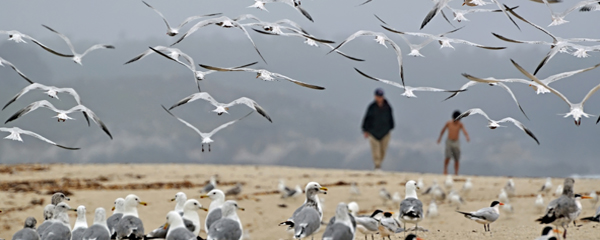
('Bird-watching at Carmel-by-the-sea' © Images by John K, 2009)
LANDSCAPES BENEATH THE SURFACE: BEST BRITISH SHORT STORIES 2017
by NICOLE MANSOUR
Raymond Carver once said that it’s “the things that are left out, that are implied, the landscape just under the smooth (but sometimes broken and unsettled) surface of things” that create the pull of a story. More often that not, those subterranean landscapes explore the prohibited, or the unmentionable; those things we find difficult to discuss or reveal. In Salt Publishing’s 2017 edition of Best British Short Stories, this landscape is shaped by themes of isolation, loneliness and the unspoken, which linger palpably just below the surface of each of these well-crafted stories.
Now in its seventh year, Best British Short Stories 2017 proves to be yet another eclectic and affective anthology of short fiction. Gathered from literary magazines, journals, newspapers, websites and other anthologies by editor Nicholas Royle, it collects together twenty works by writers: Jay Barnett, Peter Bradshaw, Rosalind Brown, Krishan Coupland, Claire Dean, Niven Govinden, Françoise Harvey, Andrew Michael Hurley, Daisy Johnson, James Kelman, Giselle Leeb, Courttia Newland, Vesna Martin, Eliot North, Irenosen Okojie, Laura Pocock, David Rose, Deidre Shanahan, Sophie Wellstood and Lara Williams.
Royle himself contributes a pithy introduction. He begins by responding to the criticism he received for commenting on the frequency editors feature their own work in anthologies in the introduction to the 2016 edition of this series, and goes on to provide an incisive overview of the multitude of high quality stories that have appeared in print and online over the past year.
The anthology opens with Courttia Newland’s ‘Reversible’, a powerful story about a police shooting, with the events narrated in an unconventional sequence. It opens with an all-too-familiar scene: a black man shot by police. As the man lies bleeding on the ground, a crowd gathers; but then, rather than depict the events that follow, Newland cleverly ‘reverses’ the action of the story:
The blood beneath the body slows to a trickle then stops. It makes a slow return inwards. There’s an infinitesimal shift of air pressure, causing fibres on the fallen baseball cap to sway like seaweed; no one sees this motion. There’s a hush in the air. Sound evaporates. The body begins to stir.
From here, the narrative regresses: the man drives his car away from the scene of the crime – ‘the tyres turn anticlockwise’ – listening to a song on the radio and considering whether or not to text his girlfriend, all the while unaware of a car that follows him. In the final paragraph, as he sits at his kitchen table, it is his mother who seems to intuit the irreversibility of what is to come – or rather, what we have just read:
His mother holds him close like a promise, one hand grasping the back of his head. Her eyes are shut. She rocks him in silence, as though he were still a boy. She knows and does not know.
Violence is again a theme in Vesna Martin’s ‘Safe’, in which a woman who is sexually assaulted by her husband and his drunken friends is later made to feel culpable for the attack – an attack which results in her husband’s death. Did she vengefully stab him with a knife or was it self-defence? As she describes events to her lawyer, he continually repeats the question, ‘Why didn’t you leave?’. But we soon learn, that despite being in a relationship where she suffers constant physical and sexual abuse, the woman’s alternatives are even less appealing. In the end, she is simply relieved to be free from danger:
It was self-defence, she had to remember that. She didn’t care either way. She had told him what it was like – she knew, she watched it happen – but if he wanted to believe something else, it was none of her business. She was fine. That force had let go of her. She was safe.
 In both Newland’s and Martin’s stories, severance and disconnection have their origins in brutality. However, it is loneliness and isolation that unambiguously permeate many of the stories here. In Krishnan Coupland’s, ‘The Sea in Me’, a young competition swimmer imagines her body to be much like that of a fish; so certain she is of this, in the closing passage she swims far out into the ocean while her boyfriend waits for her on land, leaving the reader unsure of which way she will let the current take her. Claire Dean’s protagonist in ‘Is-And’ finds herself mysteriously alone after she accompanies her reticent partner to his hometown on a rugged, rural island. And in Niven Govinden’s ‘Waves’, a patient unable to communicate with those around him, recalls a surfing holiday in Hawaii that yields mixed feelings, as he struggles to fight a life-threatening illness:
In both Newland’s and Martin’s stories, severance and disconnection have their origins in brutality. However, it is loneliness and isolation that unambiguously permeate many of the stories here. In Krishnan Coupland’s, ‘The Sea in Me’, a young competition swimmer imagines her body to be much like that of a fish; so certain she is of this, in the closing passage she swims far out into the ocean while her boyfriend waits for her on land, leaving the reader unsure of which way she will let the current take her. Claire Dean’s protagonist in ‘Is-And’ finds herself mysteriously alone after she accompanies her reticent partner to his hometown on a rugged, rural island. And in Niven Govinden’s ‘Waves’, a patient unable to communicate with those around him, recalls a surfing holiday in Hawaii that yields mixed feelings, as he struggles to fight a life-threatening illness:
Nothing about that holiday made him happy bar how his legs looked in a pair of long floral shorts, yet all he sees as the frequency of the IV drip increases is the sun breaking over the Pacific, his skin slowly warming as he moves from shadow, its tone chasing honey as it leaves its natural white and blue. He recognises that in health these dreams would not come, so that on waking there is a perverse satisfaction, thankfulness for a tiny part of what this illness brings.
As Govinden’s narrator lies in his hospital bed, we begin to understand that these dreams of Hawaii are actually lamentations for his lost youth. Despite his doctors’ reassurances that sleep and rest will make him well again, he seems lost to age and uselessness. Consequently, he is both physically and mentally isolated from the world of the living.
For me, one of the highlights of the anthology was Rosalind Brown’s ‘General Impressions of Size and Shape’. This inventive portrayal of an adulterous affair between two bird watchers is poetically evoked in metaphor:
Pre-dinner drinks in garden, chilly September, cardigans around shoulders. Then a quick movement above, face tilts back to evening sky. So does another face. Four small liquid-flying birds, forked streamers, glamorous and chasing and chattering, going south. Textbook swallows. Politely both back into the conversation.
Yet even here, Brown’s story finds its closure in quiet solitude, when the affair comes to end:
A wave of birds rising from a tree, automatically look around, what are they afraid of, several long inconclusive seconds, head cranes right back, far-off seagull, nothing else in sight. Only me.
This image of the solitary figure is also vividly rendered in another of the collections highlights, Lara Williams’s tenderly humorous story, ‘Treats’. Here, a persistently hopeful middle-aged woman named Elaine refracts embarrassment and rejection through her anonymous generosity to others, such as when she buys a movie ticket for the girl behind her in the line – ‘a fellow solo cinema goer’ – after her husband has abandoned their movie-going plans on her birthday. Elaine’s constantly cheerful battle against the ‘slow drag of disappointment’ is both heartening and distressing; then, just as Elaine exchanges a laugh with John the Sandwich Guy as she buys her lunch, Williams poignantly amplifies her desolation:
She left giggling, letting the door click softly behind her, and the thought suddenly struck her, as it occasionally did, that she didn’t have a single true friend in the whole world.
It is a compelling line that Williams has written here. For me, it illuminated what I increasingly perceive in the world as a sort of detachment from humanity, one that often seems at odds with the ease of our global connections. No doubt for some this isn’t the case – ‘likes’ and ‘followers’ mingle freely with true friends and genuine sociability. But for others, perhaps like Elaine, a surface of high spirits and congeniality is often simply just concealing a deeper loneliness.
As I reflect on these stories and their subterranean landscapes, I wonder if these solitary themes should come as a surprise at all. After all, Royle does also note in his introduction the divisive world events that have shaped our global community in the past year and half, notably Brexit and the election of Donald Trump. Certainly these events have been both rooted in, and are a provocation to, disunion within both local and international societies. Is it any wonder that people feel isolated? Misunderstood? And that as a result of this isolation violence occurs? Perhaps it is just this sense of disunity that makes these stories feel so essential: for if we can come to recognise others’ separateness, we might just find that our own lives become more peaceful, and a little less isolated.
~
 Originally from Sydney, Nicole Mansour is a former inhabitant of Buenos Aires, Melbourne, Hong Kong and London. A graduate of Actors Centre Australia, she is currently a MA creative writing student at Chichester University. Her writing has appeared online at Wildness, Thresholds, Hong Kong Review of Books, and Graphite, and her essay, ‘Beyond the Barren Landscape: Elizabeth Harrower’s A Few Days in the Country’ was longlisted for Thresholds 2016 Feature Competition. Like Susan Sontag, she loves to read the way other people love to watch television.
Originally from Sydney, Nicole Mansour is a former inhabitant of Buenos Aires, Melbourne, Hong Kong and London. A graduate of Actors Centre Australia, she is currently a MA creative writing student at Chichester University. Her writing has appeared online at Wildness, Thresholds, Hong Kong Review of Books, and Graphite, and her essay, ‘Beyond the Barren Landscape: Elizabeth Harrower’s A Few Days in the Country’ was longlisted for Thresholds 2016 Feature Competition. Like Susan Sontag, she loves to read the way other people love to watch television.

